10 Tips for Arm Balances and What They Have to Teach Us
Have you ever avoided the arm balance section of a yoga class? You know, slipped away to the bathroom just when the teacher announces that it’s time to breakdown Bakasana (Crow Pose) or (even worse) Handstand?
This has happened in my classes from time to time, less so nowadays, since I’ve learned to give LOTS of options for how to work on arm balances so that everyone has something to do where they can feel like they are working within their capacity and not opting out completely. (Spoiler alert: there are variations lying on your back or seated…the best!!)
But why should you even want to practice (or teach) arm balances?
Here’s why I teach them: Because it’s so exciting to watch students do things that they didn’t think they could ever do, AND to find variations of these poses that work for THEM.
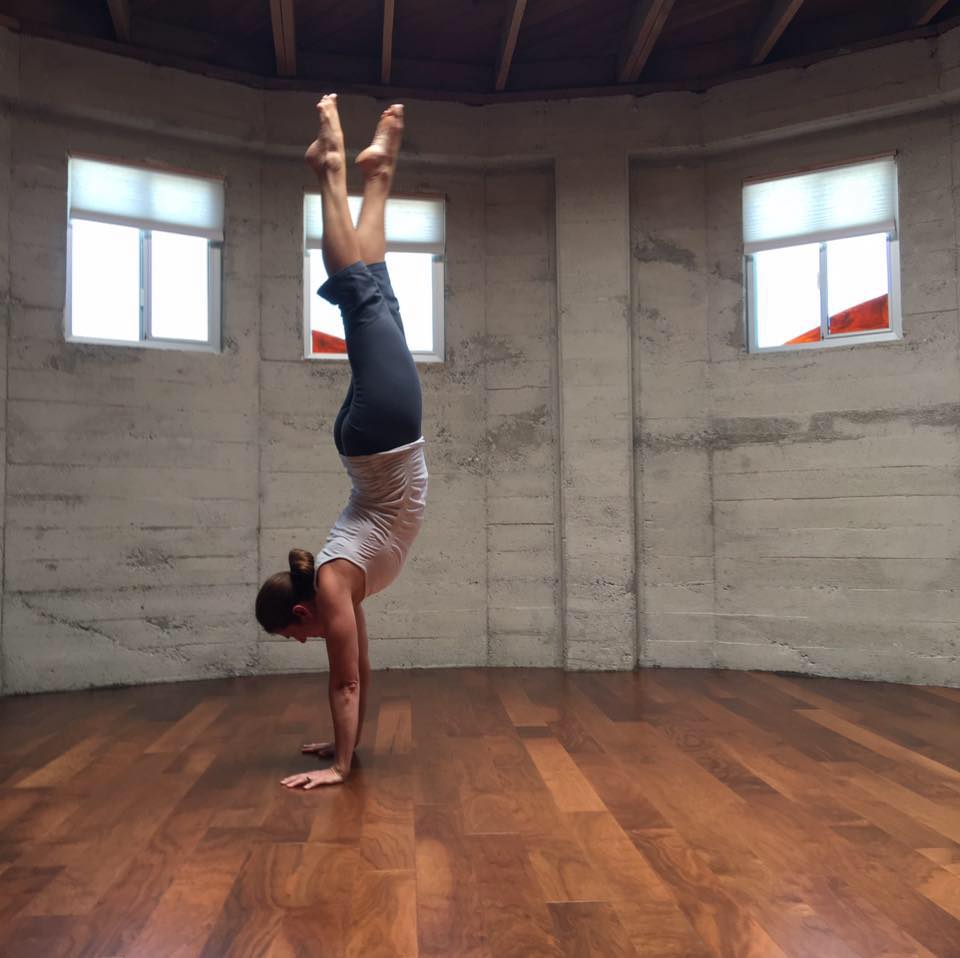
The Anatomy of Balancing on Your Hands
We do not easily balance on our hands. If you even look at the anatomy of our hands versus our feet, our hands are built for dexterity and fine motor skills, while our feet are built for moving us from place to place. The soles of our feet are broad and our toes make up a proportionately small part of our feet, giving us a sturdy surface on which to stand. Our hands, on the other hand (no pun intended) are the opposite: our kind-of unstable and long fingers make up about 80% of our handprint, making the more-stable palm proportionately much smaller, when compared to the feet.
Check out this picture of the bones of the hands and feet from Leslie Kaminoff:
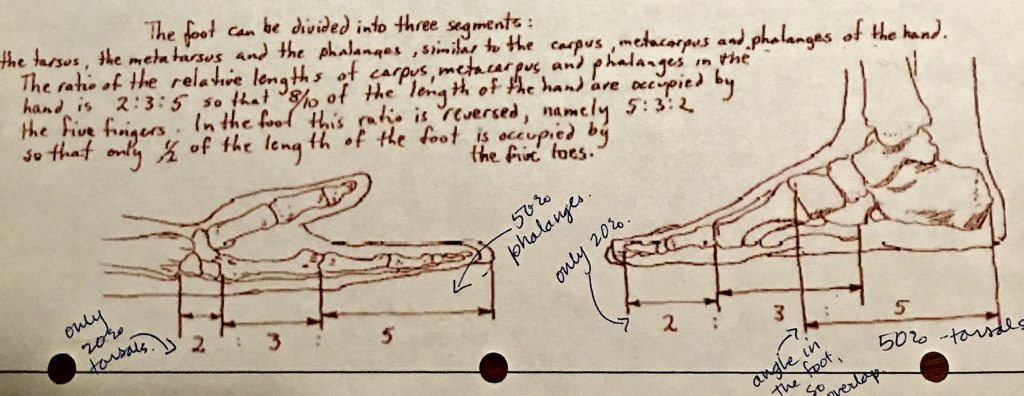
“The foot can be divided into three segments: the tarsus, the metatarsus, and the phalanges, similar to the carpus, metacarpus and phalanges of the hand. The ratio of the relative lengths of carpus, metacarpus, and phalanges is the hand is 2:3:5 so that 8/10 of the length of the hand are occupied by the five fingers. In the foot, this ratio is reversed, namely 5:3: 2 so that only 1/2 of the length of the foot is occupied by the five toes.”
We have to learn how to use our hands and fingers, along with the rest of our body in different ways when putting our body weight onto our hands.
If our hands aren’t built for this, why try?
Lots of reasons. Mainly, because it’s fun. It’s an exercise in curiosity: Can I do this? If not, why? What do I need to do in order to balance in this shape? We work with our bodies, learn where we are in space, try to control certain parts of the body, try to stay awake and aware in other parts, and we use the breath to help us. It’s a practice.
Like anything, to find balance, you have to work at it.
Some students will pop up in a arm balance that is new to them quite easily – lucky them! Body proportions, hip flexibility, and yes, arm and core strength is part of it.
(Side note: Arm balances can be more accessible to men. In fact, my husband practices only a handful of yoga postures. Legs up the wall is one of them, the odd reclined twist is another, and Crow Pose is also a pose he can get into, damn him. Men tend to have more upper body strength than women, so they can sometimes muscle their way in more easily.)
But it’s not all muscles and grit. There is a refinement of action in arm balances that I find to be very engaging. It takes work to find balance on your hands, puzzling things out, searching for the sweet spot. And surprisingly, balancing is less about strength and more about leverage and control and play and brain engagement. So put your emphasis there, as well as skill builders if you need to build strength, and these fun poses will open up for you over time.
The very first step is believing you can do it, just for that moment of practice. If not today, then perhaps someday.
Whether you think you can or you think you can’t, you’re right.
The Play in Flying
As a teacher, I love to watch this process of puzzling play out. A student literally learns to FLY before my eyes over the course of their practice. The look of excitement that comes when they get that first feeling of lift off is quite rewarding. I often say to students, “any air is good air,” because getting that first little glimpse of Bakasana (Crow Pose) by lifting one toe off the ground is pretty exhilarating. There’s a surprising feeling of levitation that is kid-like in its euphoria. It’s my version of skydiving.
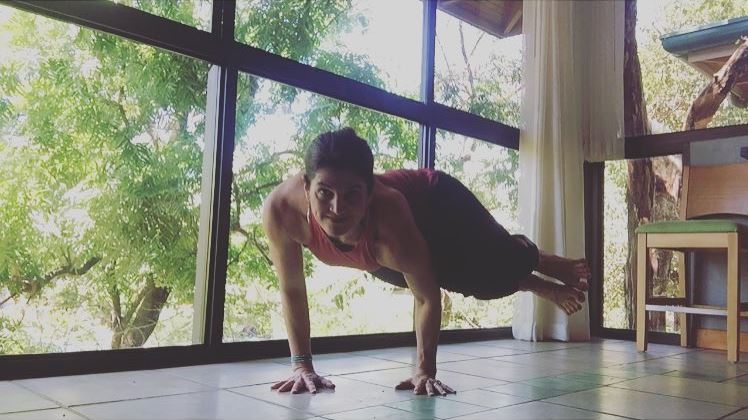
Staying Calm in the Challenge
Practicing and teaching arm balances also teach me to stay calm in the midst of a challenging situation. Studies that have been done on the benefits of yoga show that, yes, yoga is relaxing, but the most significant changes that yoga can bring us, on a neurological level, is that we can learn to calm ourselves down — to keep the breath steady, to relax the features of the face, to keep our thoughts kind and even — even when things get rough. This is worth practicing. It’s one of the main super-highways tools to living life from a place of calm response rather than frantic reaction. But we do have to PUT ourselves in those challenging situations on the mat in order to practice staying calm while we are there.
Opportunities to Practice Self-Compassion and Letting Go
When the balance and lift off DOESN’T come, despite all the effort, this is also a beneficial lesson. It can be very difficult to not get what you want, to not achieve something you’re working so hard at. It’s easy to get down on yourself and start that all-too-familiar negative self-talk.
Recognizing when we start doing this is a huge part of the practice. If we start to see a pattern of self-criticism and giving up, it may point to those same patterns off the mat. Yoga has a way of doing that. How we show up ON the mat is also usually how to we show up in life as well. Perhaps working on how we treat ourselves when we can’t find flight in an arm balance is a training ground for when we fail at something off the mat.
- Can we adjust and find another way, maybe find a variation that works better for our bodies? There are a lot of creative ways to practice the shape of arm balances seated or reclined that are not a cop-out and still are challenging.
- Can we use the lack of getting to our goal as a way to practice self-compassion? As my teacher, Christina Sell says, “If you’re always knocking it out of the park, you never get to practice self-compassion.” Perhaps being kind of ourselves is a more worthy goal than being able to conquer a particular pose.
- Can we still TRY, giving the pose our full effort, and let go of the outcome? Can we leg go of disappointment when we don’t quite get it? And even if we DO get lift off and feel like a rockstar, can we let go of that pleasure a little bit? As Stephen Cope says in The Wisdom of Yoga,: “Pleasure can be fully experienced, but must be allowed its impermanent nature. It will pass away. ‘Kiss the joy as it flies,’ said William Blake.”
Arm balances give us the opportunity to practice untangling ourselves from attachment (pleasure) and aversion (pain), which Patanjali discusses in his Yoga-Sutra as the causes of suffering (klesha). When we can lessen attachment and aversion, we start to approach our experience in the world as something BEYOND our ego, our body/mind, and go a layer deeper, remembering that we are MORE than just a body and a mind. This is a big topic. The physical practice of yoga can help us to start to realize these deeper teachings of yoga and life, and to expand our consciousness into who we truly are — manifested energy existing in the material world. Deep stuff.
10 Tips for Balancing on Your Hands
As much effort as arm balances take, there are some clear mechanics that help the process along, and tons of tips for lift off. Here are my top 10:
1. Don’t think so much about the end game. Just work on things one little step at a time and build strength at each point.
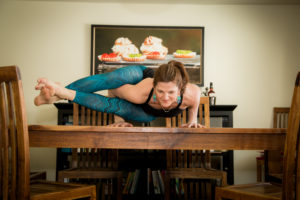 A lot of times when I first get into arm balances, I’m almost “tricked.” This was how it was when I first balanced in Astavakrasana (Crooked in Eight Places). I thought I was taking a hip class, and all of a sudden, I’m balancing on my hands! So sometimes, it best NOT to think about getting to your “goal” of balancing and just riding the flow of the practice and seeing where it lands.
A lot of times when I first get into arm balances, I’m almost “tricked.” This was how it was when I first balanced in Astavakrasana (Crooked in Eight Places). I thought I was taking a hip class, and all of a sudden, I’m balancing on my hands! So sometimes, it best NOT to think about getting to your “goal” of balancing and just riding the flow of the practice and seeing where it lands.
2. Believe you can do it
I know I already mentioned this, but it’s SO important. Just try to really believe you can do it, just for a moment. It makes all the difference. Then after you attempt, drop it and move on.
3. Take care of your wrists.
Our wrists are not used to bending at a 90 degree angle, as they are for most arm balances. It’s a big stretch for the forearms, and many people lean a little too much weight into the pinky finger side of their wrists, which puts a LOT of force onto bones and muscles that can’t support that. A couple of things can help:
- Move more weight onto the inside edges of the hands/wrists by pressing down into the L of the index finger and thumb. This will more evenly distribute the force.
- Do wrist and finger mobility and strengthening exercises like open/close fists and tabletop wrist stretches (short video??)
- Don’t forget about the chest! Using a tennis ball or YogaTuneUp ball right at the armpit chest can have effects right down the arm.
If you’re not able to bear any weight on the arms, there are still ways you can work on the shapes of arm balances by taking them supine or seated! This is a really fun (and challenging) way to work on these poses and do SOMETHING, rather than totally opting out. Also, as a teacher, it’s a great way to keep your mixed-level classes rolling when you teach supine versions, seated versions, then arm balance versions so that everyone has choices and routes to take. Check out this reclined version of Flying Pigeon…one of my favorites!
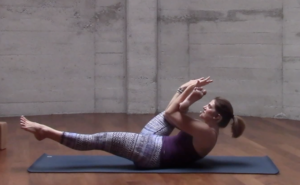
Also, sometimes you can also find ways to balance on your forearms to take the pressure off. These versions can be more challenging or less, depending on your body, but they are fun to experiment with. Baby Crow is an example. Some arm balances simply don’t have forearm variations, since you are resting on the shelf of your arms with bent elbows, but you’d be surprised by what you can come up with.
4. USE your legs!
Many students believe that arm balances are all about the arms and core. But the LEGS are a huge part of arm balances. Also, a lot of arm balances have a lot to do with moving the legs into different shapes, which means that the HIPS are involved. Often, working on hip mobility and engagement of the legs can propel students forward, more than arm and core strength will.
5. Leverage is your friend.
Also, arm balances are about LEVERAGE. We are working with holding our bodies in different shapes in relation to gravity, so physics comes into play. Often, finding balance is a matter of lowering one part of the body so that another part can lift, like a seesaw. Usually, the part to lower will be the FACE, moving it closer to the Earth, which can be scary. So we have to talk about fear.
6. Gaze FORWARD
Often, students will look back at their feet or hips to see if anything is going to lift up. But if you do that, you will either (1) not be able to lift up because you need to counterbalance of your chin lifting to get your legs up, or (2) do a sommersalt or a Faceplant (common in Crow). Try looking forward! This has been key for several of my students.
7. Don’t forget about the feet.
Floppy feet equal heavy legs and hips. Active feet (flexed, toes spread) equal lightness! it’s like carrying a sleeping child up the stairs. They are so heavy, right? But the moment they wake up, they are able to help you, and things get easier. So wake up your feet!
8. Learn the basic setup.
Often, you just need someone to tell you how to get setup. In our run-of-the-mill Vinyasa classes, rarely will a teacher talk you through how to set up the hands and feet for the pose. And when you can slow down and hear how to set up, follow one step at a time. It helps!!
9. Practice.
This is the thing. When you’re trying to find balance, no one can really spot you or help you into the position of hand balances like Crow, Side Crow, Flying Pigeon, etc. You just have to practice. Practice the lean forward, the press down, the activation in the feet, all of it. And it comes with time. Your body sorts it out over a period of coming back to it. You’re looking for that sweet spot. And it really is a sweet feeling when the balance is almost effortless because you’ve found a way to stack the bones up so that the muscles aren’t doing ALL of the work. Then, BREATHE. There’s nothing like it!
10. Know that you can have a long and happy life, even if you never find flight.
The benefits we get from practicing these poses — namely, patience, brain engagement, self-compassion, belief in our ability to try, discernment to know how to practice them safety, body and mind awareness and more — these qualities are MUCH more worthy goals than ever balancing in these fancy poses. So relax, and know that practicing these poses is much less about “getting the pose” than what you learn about yourself along the way.
And isn’t that what yoga is all about anyway? I think so.
I’d love to know what you think. Let me know in the comments below! Practice Well!
Wanna practice some arm balances? Let’s do it.
Learn how to do Crow Pose!! Online studio members, take my Pose Elements class on Bakasana (Crow Pose), part of my online class library. 37-minutes with lots of breakdown tips, key actions, and variations to play with. You’ll learn a ton! Watch the sample here.
As a member of my library ($15/month & you can cancel anytime), you’ll have unlimited access to all of my online classes. 7-day free trial!
Check out the library, watch the sample videos, and sign up using the “Buy” button.

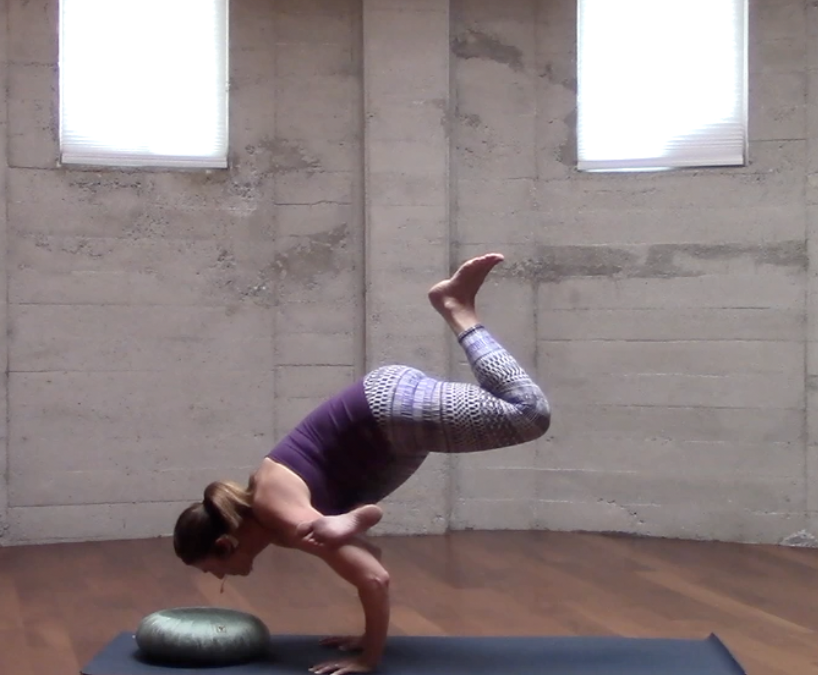
 Empowering women who are 40+ to install movement habits that are nourishing, strengthening, and approachable for a truly calm and connected life.
Empowering women who are 40+ to install movement habits that are nourishing, strengthening, and approachable for a truly calm and connected life.